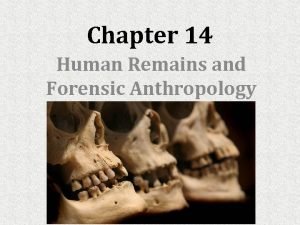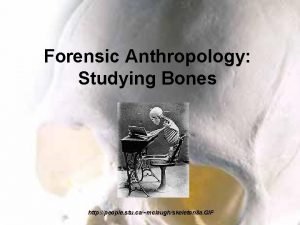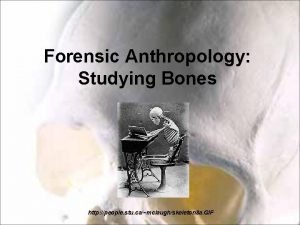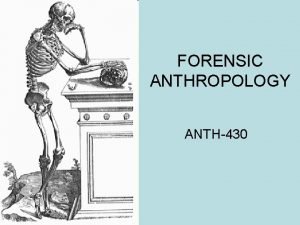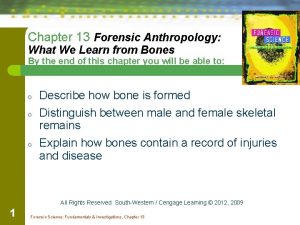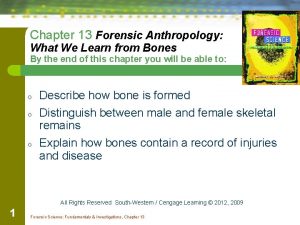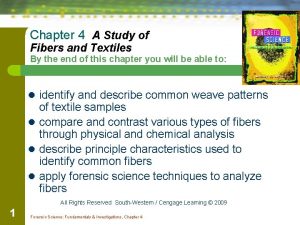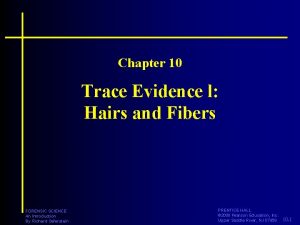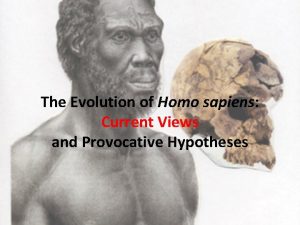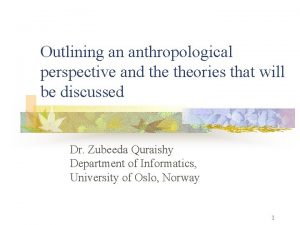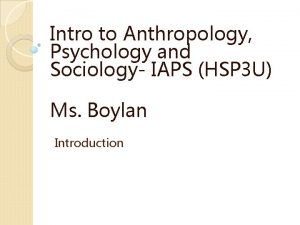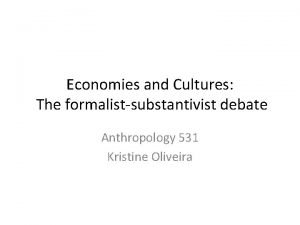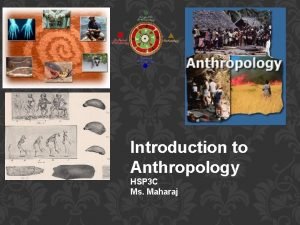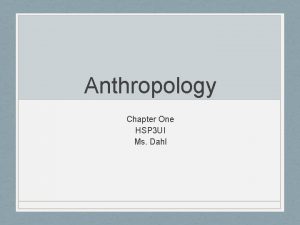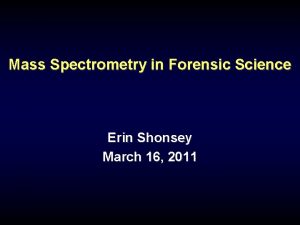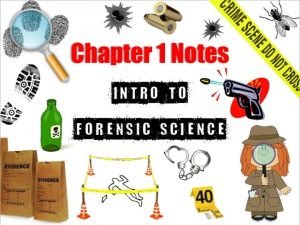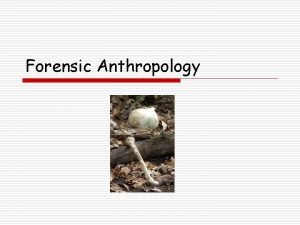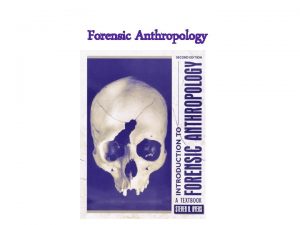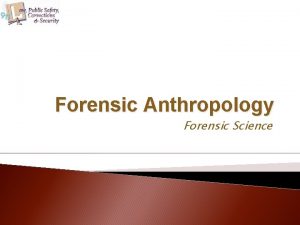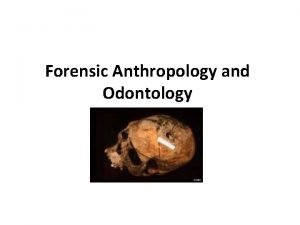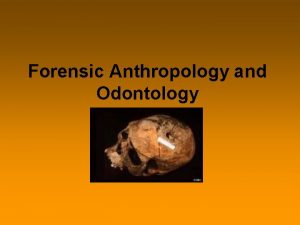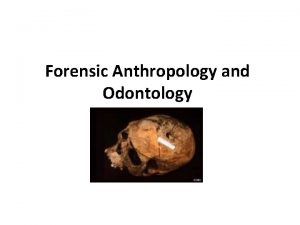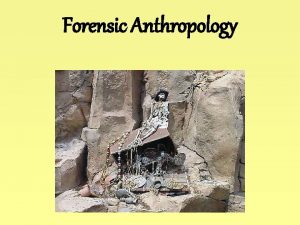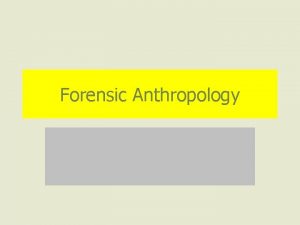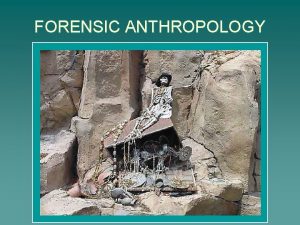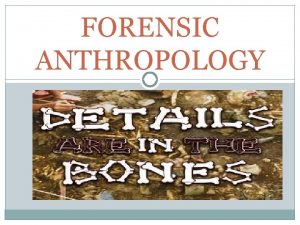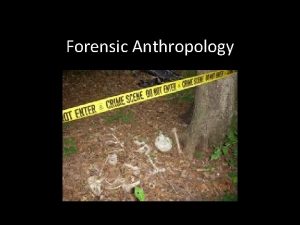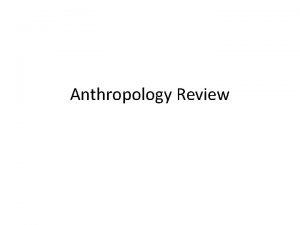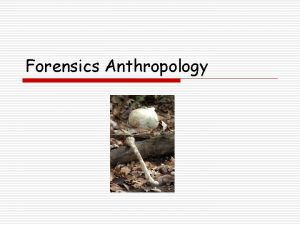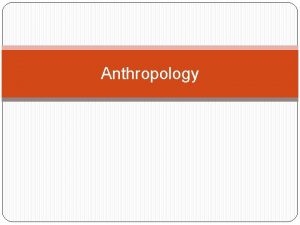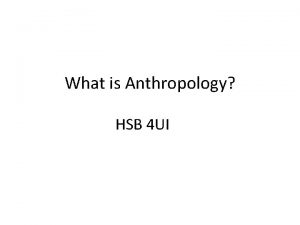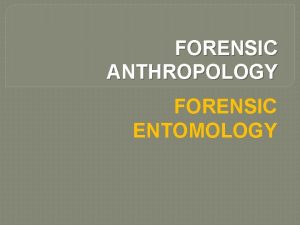Forensic Anthropology Forensic Science Copyright and Terms of
































- Slides: 32

Forensic Anthropology Forensic Science

Copyright and Terms of Service Copyright © Texas Education Agency, 2011. These materials are copyrighted © and trademarked ™ as the property of the Texas Education Agency (TEA) and may not be reproduced without the express written permission of TEA, except under the following conditions: 1) Texas public school districts, charter schools, and Education Service Centers may reproduce and use copies of the Materials and Related Materials for the districts’ and schools’ educational use without obtaining permission from TEA. 2) Residents of the state of Texas may reproduce and use copies of the Materials and Related Materials for individual personal use only, without obtaining written permission of TEA. 3) Any portion reproduced must be reproduced in its entirety and remain unedited, unaltered and unchanged in any way. 4) No monetary charge can be made for the reproduced materials or any document containing them; however, a reasonable charge to cover only the cost of reproduction and distribution may be charged. Private entities or persons located in Texas that are not Texas public school districts, Texas Education Service Centers, or Texas charter schools or any entity, whether public or private, educational or non-educational, located outside the state of Texas MUST obtain written approval from TEA and will be required to enter into a license agreement that may involve the payment of a licensing fee or a royalty. Contact TEA Copyrights with any questions you may have. Copyright © Texas Education Agency 2011. All rights reserved. Images and other multimedia content used with permission. 2

Forensic Anthropology Ø The study of skeletonized human remains and the time of death to try to establish the identity and cause of death of an individual Copyright © Texas Education Agency 2011. All rights reserved. Images and other multimedia content used with permission. 3

Forensic Anthropology (continued) Can possibly identify the following ◦ Age ◦ Sex ◦ Race ◦ Height ◦ Pathologies that may be present ◦ Whether trauma is evident Copyright © Texas Education Agency 2011. All rights reserved. Images and other multimedia content used with permission. 4

Forensic Anthropology (continued) When bones are found, the following should be answered: ◦ Are they really bones or some other type of material? ◦ Are they human bones? ◦ Is there only one individual present or more than one? ◦ How long have the bones been there? ◦ What is the cause of death? ◦ Who is this? Copyright © Texas Education Agency 2011. All rights reserved. Images and other multimedia content used with permission. 5

Forensic Anthropology: Age Determination Sutures ◦ Zigzag-like cracks on the skull ◦ Are separate at birth, but gradually close from the inside out ◦ The older the individual, the less visible the sutures In toddlers and infants, length of the long bones are measured and compared to known growth curves After age 21, age is estimated by the level of change on the surfaces of the bones Copyright © Texas Education Agency 2011. All rights reserved. Images and other multimedia content used with permission. 6

Forensic Anthropology: Age Determination (continued) Infant skull with sutures visible End of this femur is rough, indicating a juvenile Copyright © Texas Education Agency 2011. All rights reserved. Images and other multimedia content used with permission. 7

Forensic Anthropology: Gender Determination MALE FEMALE Narrow pelvic opening Larger, circular pelvic opening Long, narrow sacrum Wide sacrum Acute (less than 900) subpubic angle Wide subpubic angle (approximately 900) Larger skull overall Smaller skull Pronounced brow bone Diminished brow bone Overall robust skeleton Overall slender skeleton Copyright © Texas Education Agency 2011. All rights reserved. Images and other multimedia content used with permission. 8

Forensic Anthropology: Gender Determination (continued) FEMALE PELVIS Copyright © Texas Education Agency 2011. All rights reserved. Images and other multimedia content used with permission. 9

Forensic Anthropology: Gender Determination (continued) Male or Female? Why? Copyright © Texas Education Agency 2011. All rights reserved. Images and other multimedia content used with permission. 10

Forensic Anthropology: Gender Determination (continued) FEMALE PELVIC OPENING Copyright © Texas Education Agency 2011. All rights reserved. Images and other multimedia content used with permission. 11

Forensic Anthropology: Gender Determination (continued) FEMALE SKULL Copyright © Texas Education Agency 2011. All rights reserved. Images and other multimedia content used with permission. 12

Forensic Anthropology: Gender Determination (continued) FEMALE SKULL Copyright © Texas Education Agency 2011. All rights reserved. Images and other multimedia content used with permission. 13

Forensic Anthropology: Race Determination Ø Most commonly divided into 3 categories Mongoloid (Asian or Native descent) Caucasoid (European) Negroid (African) Copyright © Texas Education Agency 2011. All rights reserved. Images and other multimedia content used with permission. 14

Forensic Anthropology: Race Determination (continued) Mongoloid (Asian or Native descent) ◦ Flat or projected outward frontal plane ◦ Small, rounded nasal cavities ◦ Circular eye orbits Copyright © Texas Education Agency 2011. All rights reserved. Images and other multimedia content used with permission. 15

Forensic Anthropology: Race Determination (continued) Caucasoid (European) ◦ Flat cranium ◦ Long, narrow nasal cavities ◦ Oval eye orbits Copyright © Texas Education Agency 2011. All rights reserved. Images and other multimedia content used with permission. 16

Forensic Anthropology: Race Determination (continued) Negroid (African) ◦ Cranium projected outward ◦ Wide nasal cavity ◦ Square eye orbits Copyright © Texas Education Agency 2011. All rights reserved. Images and other multimedia content used with permission. 17

Forensic Anthropology: Height Determination Determined by measuring the long bones and calculating from known equations The equations are different based on the bone, the race of the individual, and the gender The long bones used are the femur, radius, tibia, and humerus Copyright © Texas Education Agency 2011. All rights reserved. Images and other multimedia content used with permission. 18

Forensic Anthropology: Other Determining Factors A forensic anthropologist or sculptor may create facial reconstructions from skulls to help identify skeletal remains Pathological identities such as past surgeries, and broken bones that show healing and/or scarring Trauma may be studied by observing cracks, holes, or toolmarks present on bones Copyright © Texas Education Agency 2011. All rights reserved. Images and other multimedia content used with permission. 19

Excavation of Skeletal Remains These are the guidelines provided to expose and recover remains in order to minimize damage Guidelines will differ based on scene conditions Copyright © Texas Education Agency 2011. All rights reserved. Images and other multimedia content used with permission. 20

Excavation of Skeletal Remains (continued) Steps to excavation ◦ Remove litter and vegetation if present ◦ Stake out and map the exact excavation area ◦ Determine the grave outline and remove the soil covering; sift each layer to check for evidence or small bones ◦ Work in horizontal layers ◦ Document as work continues with photography, maps, inventory, and measurements ◦ Once all bones have been exposed, document them again ◦ Remove each bone separately and bag it individually Copyright © Texas Education Agency 2011. All rights reserved. Images and other multimedia content used with permission. 21

Forensic Odontology is the study of teeth and bite marks for individual identification ◦ Can estimate age by observing deciduous teeth in children and wear patterns in older adults ◦ Can be compared to dental records ◦ May contain DNA ◦ Teeth are harder to destroy in fire than bone ◦ Can be used with bite mark identification Copyright © Texas Education Agency 2011. All rights reserved. Images and other multimedia content used with permission. 22

Human Death If death has occurred, the following must be determined: ◦ Cause The disease or injury responsible for initiating the sequence of events that resulted in death Examples Gunshot wound Drug overdose Cardiovascular disease Copyright © Texas Education Agency 2011. All rights reserved. Images and other multimedia content used with permission. 23

Human Death (continued) Manner ◦ The “reason” the cause of death occurred ◦ Categories Accidental Homicidal Natural Suicidal Undetermined Copyright © Texas Education Agency 2011. All rights reserved. Images and other multimedia content used with permission. 24

Human Death (continued) Mechanism ◦ The immediate physiological derangement resulting in death ◦ Examples Hemorrhage Cardiac arrhythmia Copyright © Texas Education Agency 2011. All rights reserved. Images and other multimedia content used with permission. 25

Forensic Anthropology: Stages of Decomposition STAGE CHARACTERISTICS Fresh Immediately after death Blood is not pumping, so it drains and pools to lower parts creating livor mortis, or lividity Rigor mortis, the stiffening of the muscles, can also be seen Bloat When anaerobic metabolism causes gases to build up, making a body swell or bloat Can cause fluids to leak or “purge” from orifices Active Decay Greatest body mass loss Most of the tissue is liquefied Strong odors persist Much of the maggot mass pupates Advanced Decay Little insect activity Bones are revealed Dry Remains All that remains is dry skin, cartilage, and bones either partially or fully skeletonized Copyright © Texas Education Agency 2011. All rights reserved. Images and other multimedia content used with permission. 26

Forensic Entomology Forensic entomology is the study of insects and their life cycles to determine how long a body has been deceased When a dead body is present, necrophilious insects, or insects that feed on dead tissue, will usually infest it within 24 hours Copyright © Texas Education Agency 2011. All rights reserved. Images and other multimedia content used with permission. 27

Forensic Entomology (continued) The first and most commonly found insect is the adult blow fly, along with eggs, larvae, and pupae Copyright © Texas Education Agency 2011. All rights reserved. Images and other multimedia content used with permission. 28

Forensic Entomology (continued) Other insects include ◦ Several types of beetles that can either be necrophilious or predatory on other insects ◦ Predator insects that prey on necrophilious insects Copyright © Texas Education Agency 2011. All rights reserved. Images and other multimedia content used with permission. 29

Forensic Entomology (continued) Omnivorous insects such as ants and wasps that may feed on the body itself, other insects, or surrounding vegetation Indigenous insects, and/or spiders, may be present, but their presence is usually coincidental to the location of the body Copyright © Texas Education Agency 2011. All rights reserved. Images and other multimedia content used with permission. 30

Forensic Entomology (continued) The timeframe for lifecycle development is influenced by environmental conditions such as ◦ Climate ◦ Weather ◦ Geographical location ◦ Drugs or toxins present in the body Copyright © Texas Education Agency 2011. All rights reserved. Images and other multimedia content used with permission. 31

Resources Ø Saferstein, Richard. Forensic Science: An Introduction. New Jersey: Pearson Prentice Hall, 2008 Ø Saferstein, Richard. Forensic Science: An Introduction. 2 nd ed. New Jersey: Pearson Prentice Hall, 2011 Ø Saferstein, Richard. Criminalistics: An Introduction to Forensic Science. 8 th ed. Upper Saddle River, NJ; Pearson Prentice Hall, 2004 Ø Do an Internet search for the following articles: Ø forensic science central John Wayne Gacy Ø forensic anthropology by Katherine Ramsland 32
 Forensic anthropology unit
Forensic anthropology unit Forensic anthropology
Forensic anthropology Nasal silling guttering
Nasal silling guttering Nasal silling and guttering
Nasal silling and guttering Forensic anthropology data bank
Forensic anthropology data bank Chapter 13 forensic anthropology
Chapter 13 forensic anthropology Chapter 13 forensic anthropology
Chapter 13 forensic anthropology Polynomial classification
Polynomial classification What are like terms
What are like terms Pe is my favourite subject
Pe is my favourite subject Thomas mocker and thomas stewart
Thomas mocker and thomas stewart Forensic psychiatry vs forensic psychology
Forensic psychiatry vs forensic psychology Chapter 6 fingerprints
Chapter 6 fingerprints Fibers are woven into textiles or fabrics
Fibers are woven into textiles or fabrics Chapter 1 introduction to forensic science and the law
Chapter 1 introduction to forensic science and the law Hairs and fibers in forensic science
Hairs and fibers in forensic science Copyright science stuff
Copyright science stuff Make me genius videos
Make me genius videos Copyright science stuff
Copyright science stuff Lumpers and splitters anthropology
Lumpers and splitters anthropology Anthropology perspective examples
Anthropology perspective examples Anthropology psychology and sociology
Anthropology psychology and sociology Substantivist vs formalist
Substantivist vs formalist Venn diagram of anthropology and sociology
Venn diagram of anthropology and sociology Hsp 3c
Hsp 3c Introduction to anthropology psychology and sociology
Introduction to anthropology psychology and sociology Anthropology and its branches
Anthropology and its branches Sola pith forensic
Sola pith forensic Keratin definition forensics
Keratin definition forensics Mass spectrometry in forensic science
Mass spectrometry in forensic science Forensic science branches
Forensic science branches Different types of serial killers
Different types of serial killers Important people in forensic science
Important people in forensic science
